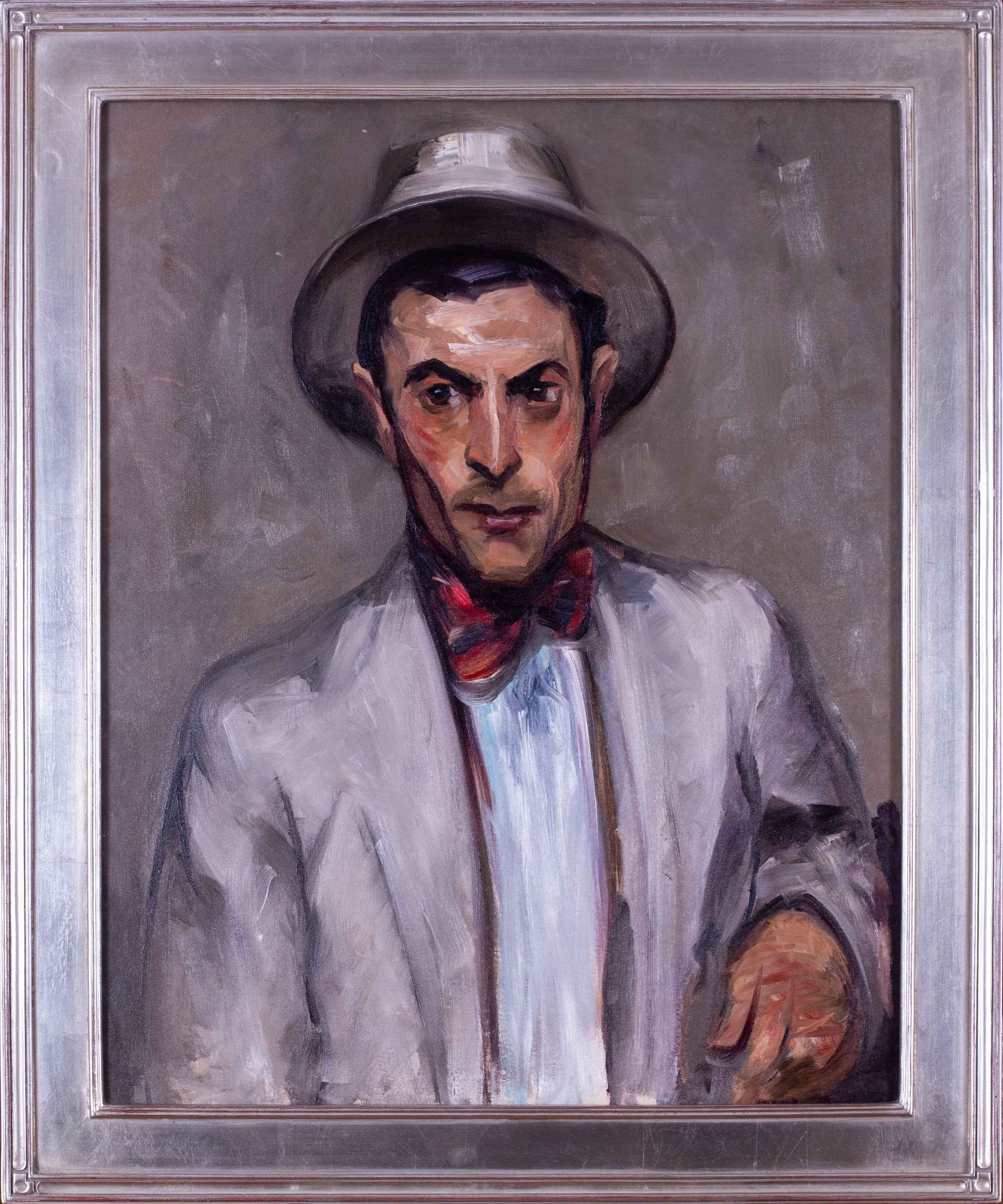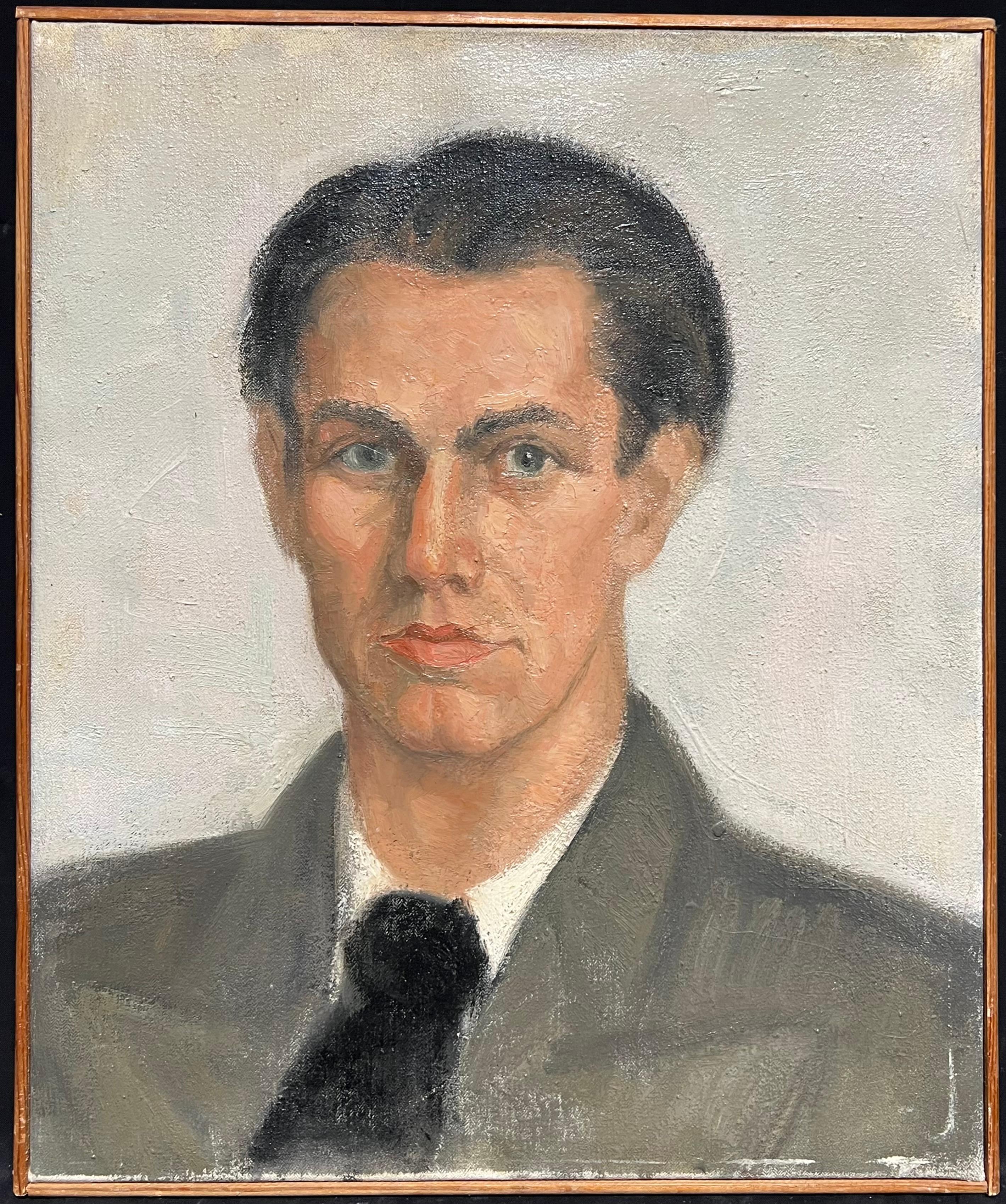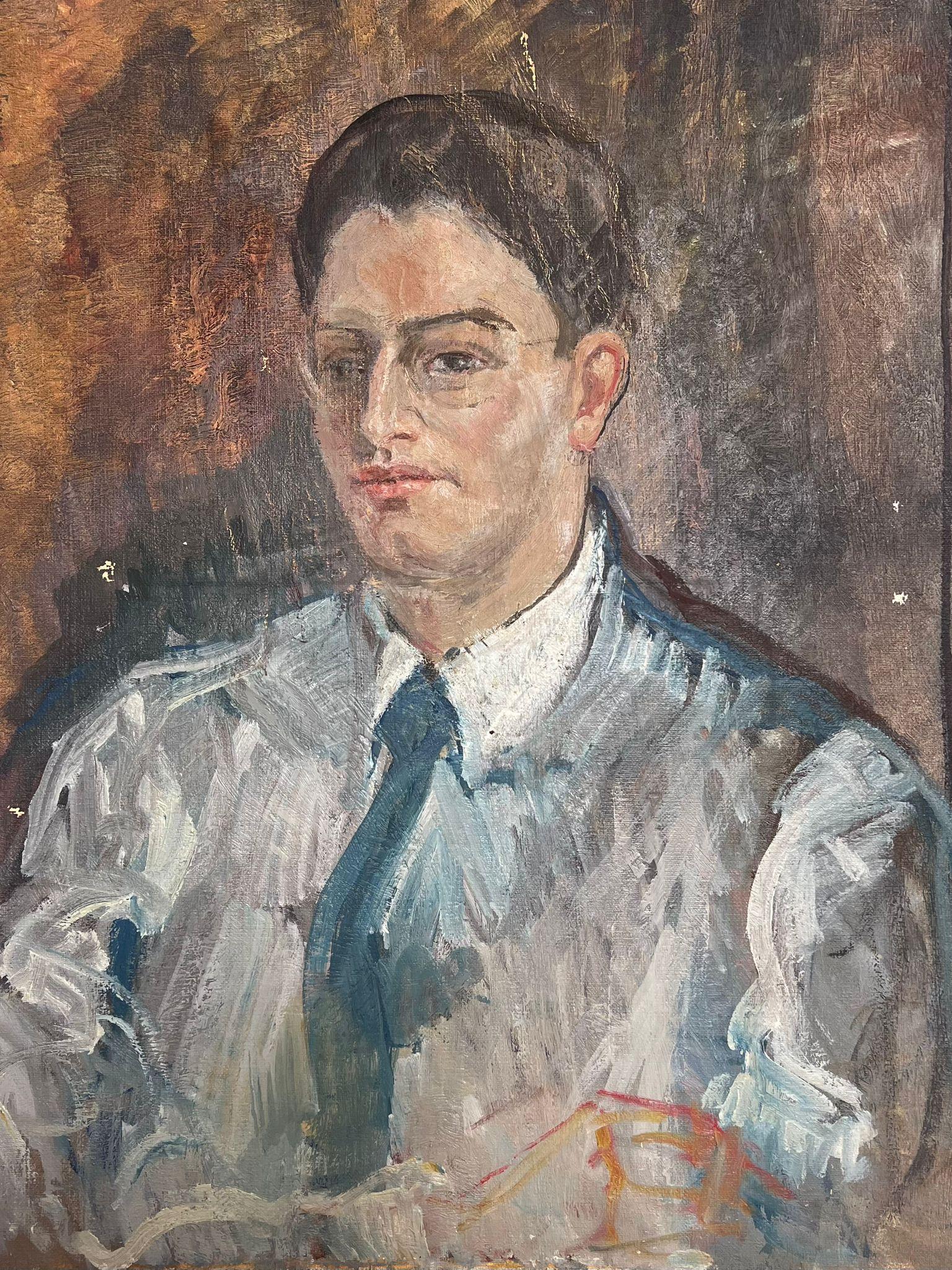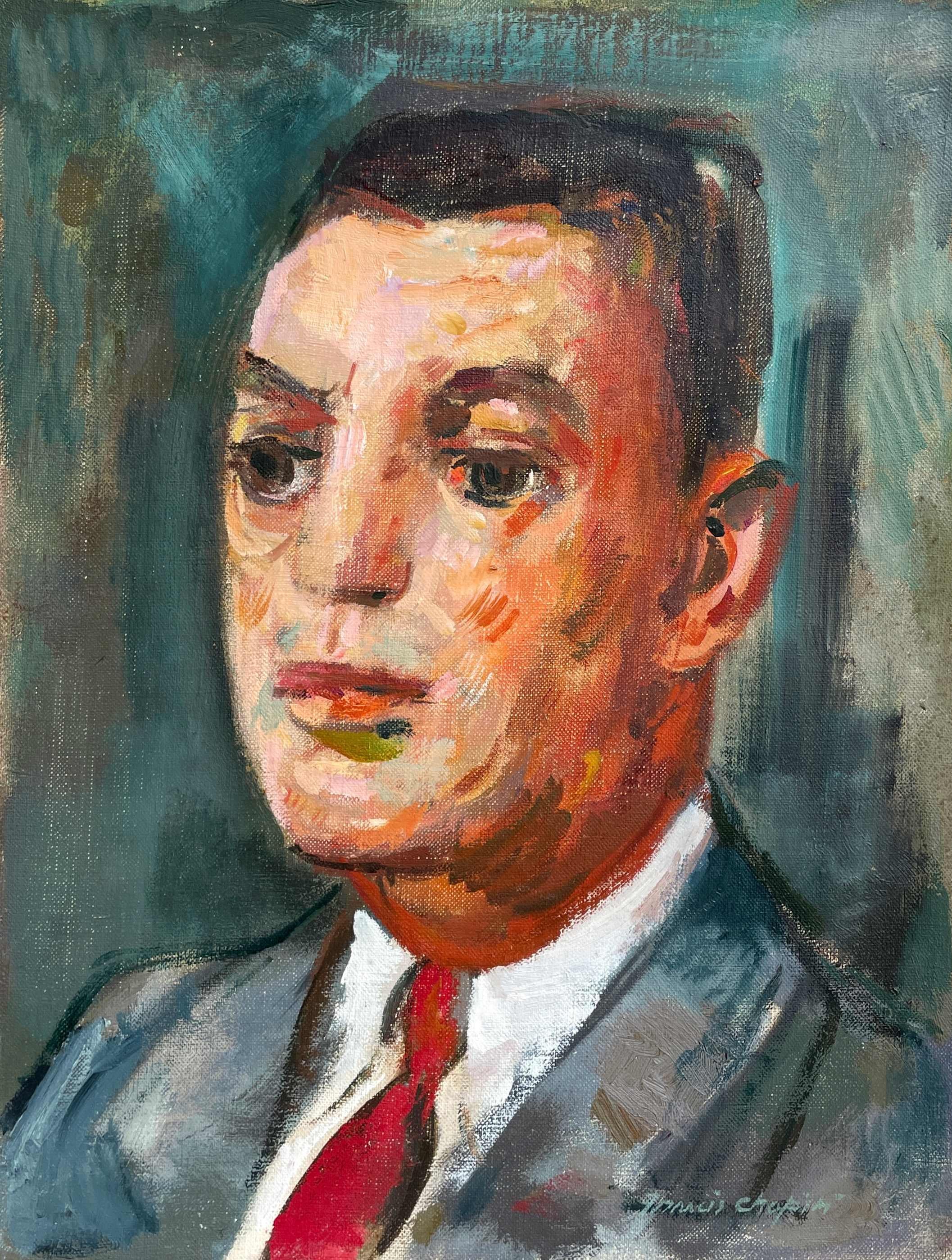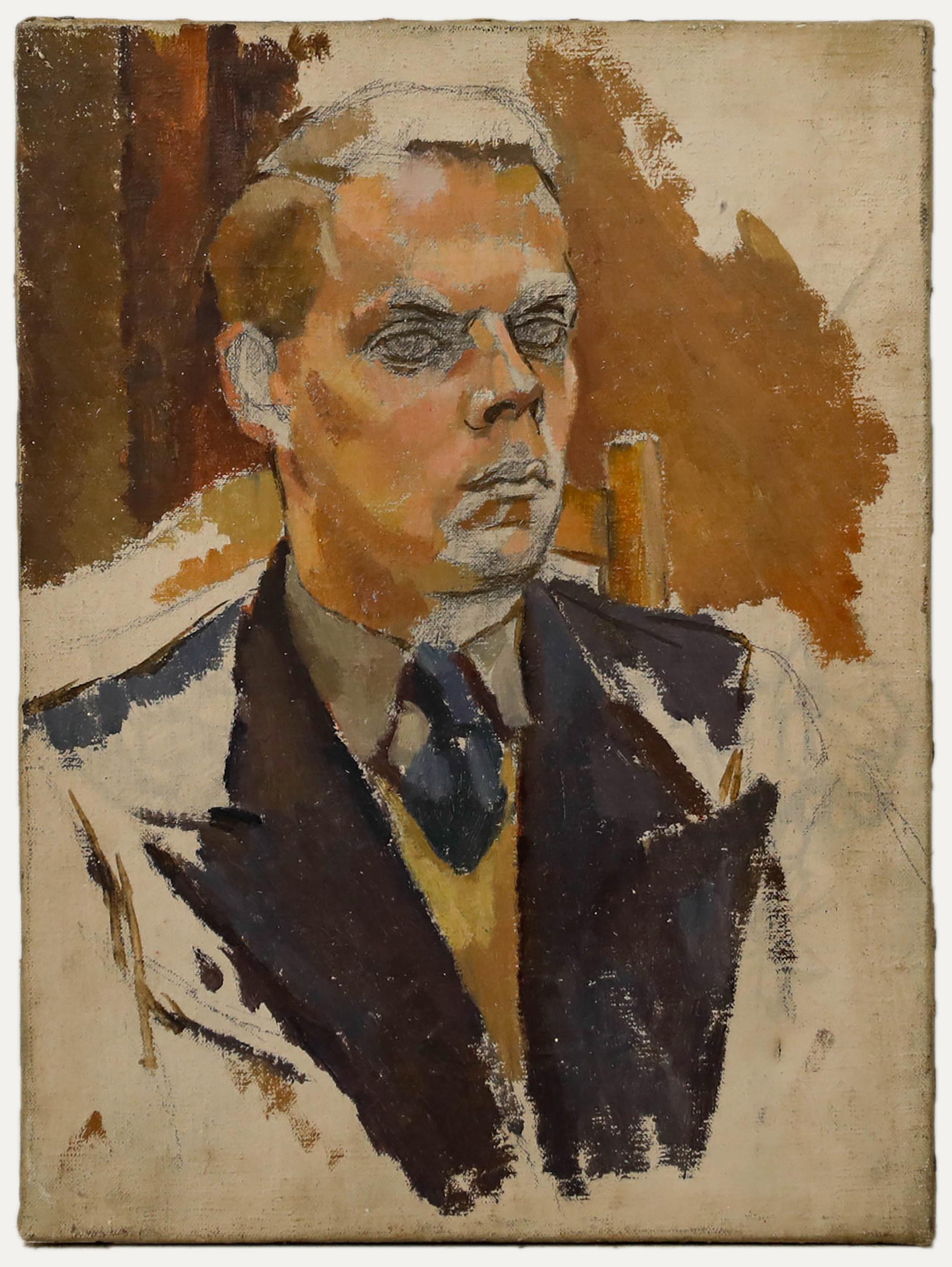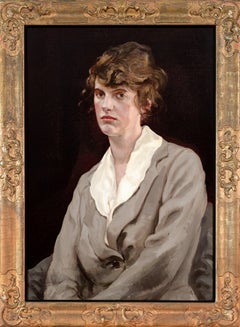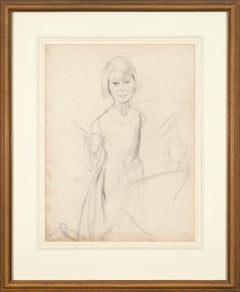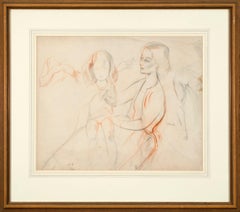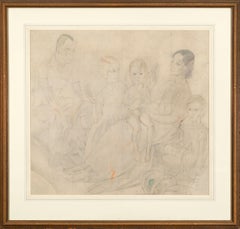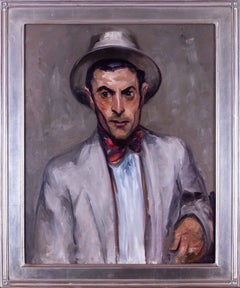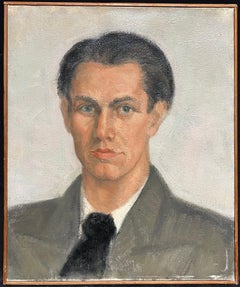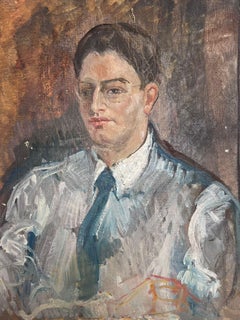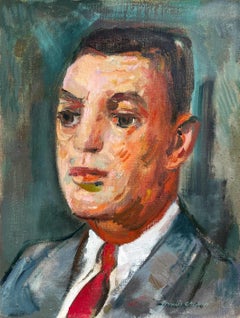Items Similar to Young Man in a Red Tie
Video Loading
Want more images or videos?
Request additional images or videos from the seller
1 of 13
Ethel WalkerYoung Man in a Red Tie
$16,900.83
£12,250
€14,451.07
CA$23,246.83
A$25,840.30
CHF 13,544.93
MX$315,572.55
NOK 169,100.63
SEK 159,092.15
DKK 107,858.57
About the Item
Dame Ethel Walker DBE ARA (1861-1951)
Young Man in a Red Tie
Oil on canvas
51 x 40.6 cm.; (within frame) 70 x 59.7 cm.
Provenance:
The Lefevre Gallery, London, stock number X890;
Christie’s, London, Modern British Pictures, Watercolours, Drawings and Sculpture, 12 September 1996, lot 58;
Bonhams, London, Modern British and Irish Art, 23 November 2022, lot 177;
Private Collection, United Kingdom.
This focussed composition is dominated by a handsome young man in profile, frowning with a concentrated glare. His slender cheeks meet a jaw brushed with a masculine grey, complimented by the blue of a flower or pocket square, and the shadow of a loose strand of oiled hair that rests across his forehead. The stylistic sophistication shows Walker at her best, ambitiously combining measured figuration with expressive abstraction, as delicious dashes of pigment appear still wet, and dissonant swipes energetically mark the surface of the canvas. With an elegance that borders on the effete, the sitter’s urbane style includes a spearpoint collar, framed by the wide lapels of his suit jacket. Most significantly, the young man’s dandyish fashion is augmented by the conspicuous titular red tie which he wears – an established expression of queerness in the 20th century. Painted by the lesbian artist Dame Ethel Walker, it is likely that the portrait is that of a gay man belonging to London’s queer artistic circles. Indeed, Walker’s male sitters (who constitute but a fraction of her output) are typically conceived as modish, and often wear striking colourful ties. Walker was one of the earliest lesbian artists to overtly explore her sexuality in her works, and an aesthetic fascination with the female form culminated with her glorious large-scale ‘decorations’, exemplified by Decoration: The Excursion of Nausicaa (Tate, N03885).
Red neckties had been established in the 20th century as a coded (though appropriately colourful) expression of queerness, not dissimilar to the green carnation of the Wildean aesthetes. The gay writer and musician Mikhail Kuzmin was painted in 1909 in a stark red tie. Two decades later, the Anglo-French physician Havelock Ellis described the red necktie as an emblem amongst queer New Yorkers: ‘[…] there has been a fashion for a red tie to be adopted by inverts [homosexuals] as their badge’ (Ellis, p. 299). The motif permeated fiction, and in Thomas Mann’s 1912 novel Death In Venice, the protagonist Gustav von Aschenbach begins to wear a red necktie after he develops an infatuation with a beautiful young boy staying at his hotel. William Faulkner’s 1929 novel The Sound and the Fury includes an unnamed male character identified throughout by his distinctive red necktie, which is the subject of veiled insinuations against his masculinity.
Walker must surely have been familiar with this symbolic importance when she executed the present portrait. Her few portraits of male sitters include colourful neckties almost exclusively, and include numerous examples of red neckties. Indeed, the artist herself preferred to wear a red tie, a declaration which so impressed itself on Virginia Woolf that she noted it in a diary entry after tea with Walker (Bell, p. 282). Walker, who painted Woolf’s sister Vanessa Bell, had once offered to paint Woolf in the nude, as Lilith. Around the same time, Augustus John painted the gay peer Evan Morgan, 2nd Viscount Tredegar, in a loose red necktie or neck scarf. The portrait passed through the Lefevre Gallery, which also represented Walker, and which inventoried the present work. While the sartorial choice may have been incidental, a colourful accessory chosen to enliven the portrait, its prominent inclusion would suggest a personal significance to Walker, the recognition of a shared experience between artist and subject.
Dame Ethel Walker was hailed as a leading female artist of her generation, and as late as 2010 was one of only four women artists to have been honoured as a Dame Commander of the Order of the British Empire. Walker was born in Edinburgh in 1861 to the botanist Arthur Abney Walker, a descendent of the Walker family of iron industrialists, whose estates included Clifton House (Rotherham) and Blythe Hall (Nottinghamshire). She attended school in London after the family moved to Wimbledon, and in 1880 met the fellow artist Clara Christian, with whom she would form an important personal and professional bond. The women’s relationship was later allegorised by the writer George Moore as that of Stella (Christian) and Florence (Walker) in his fictionalised three-volume memoir Hail and Farewell. Walker went on to Putney School of Art and Westminster School of Art, and studied under Frederick Brown, who became a lifelong mentor. Around 1893 Walker took further study at the Slade School of Art, partly under Walter Sickert, and returned in 1912, 1916, and 1921. Although Walker enjoyed painting floral still lifes and seascapes, her best work was portraiture. She worked from her studio at 38 Cheyne Walk for most of her career, and enjoyed a prominent role in London’s artistic milieu. Her sitters included the artists Lucien Pissarro, Orovida Camille Pissarro, Vanessa Bell, and Barbara Hepworth; she painted Nancy Astor, the Countess of Strathcona, the editor Joan Werner Laurie, and author Leo Walmsley. The actors Flora Robson and Elsa Lanchester sat for Walker, as did the young Christopher Robin Milne. Walker herself was photographed by the bisexual photographer and painter Humphrey Spender, who pictured London’s queer artists and writers, such as Christopher Isherwood and W.H. Auden.
Walker began exhibiting at the Royal Academy in 1898, where she would become one of the most frequently exhibited women artists (alongside Laura Knight and Dod Procter). She exhibited at least six times with the Lefevre Gallery, and had numerous shows at the Redfern Gallery. She was selected to represent Britain at the Venice Biennale four times (1922, 1924, 1928 and 1930), and was in 1940 made an Associate of the Royal Academy. Her presence in the London scene made for a number of successes, and she became the first female member of the New English Art Club in 1900, and was afterwards elected as the Honorary President of the Women’s International Art Club. The Tate purchased works directly from Walker during her own lifetime, and after her death in 1951 held a major retrospective for her alongside Gwen John and Frances Hodgkins. Her works are held in important public collections across the United Kingdom, including acquisitions made by The Queen Mother for the Royal Collection. The Tate’s 2017 exhibition Queer British Art 1861-1967 featured Walker’s Decoration: The Excursion of Nausicaa.
The canvas and frame are marked considerably verso, including inscriptions and labels that correspond to those on other works by the artist. One sticker to the top stretcher bar is that of the Lefevre Gallery, with the stock number X890. Despite the best efforts of the Lefevre archives, the relevant stock book is currently misplaced, and as such further information is not presently available. However, the ‘X’ indicates that the work came to Lefevre from the artist herself. A hand-written note affixed to the canvas reads, ‘NR113 / Young man with a red tie / M’, and is possibly that made by an executor following Walker’s death in 1951.
Bibliography and further reading:
Barlow, Claire, Queer British Art, 1867-1967 (London: Abrams, 2017)
Bell, Anne Olivier, The Diary of Virginia Woolf: 1931-1935 (New York, N.Y.: Harcourt Brace Jovanovich, 1977)
Chauncey, George, Gay New York: Gender, Urban Culture, and the Making of the Gay Male World, 1890-1940 (New York: Harper Collins, 1994)
Ellis, Havelock, Studies in the Psychology of Sex, Volume II: Sexual Inversions, 3rd ed. (Philadelphia, F. A. Davis, 1926)
Pearce, Brian Louis, Ethel Walker: An Essay in Reassessment (London: Stride, 1997)
Yu, Mengting, London’s Women Artists, 1900-1914: A Talented and Decorative Group (Singapore: Springer Nature, 2020)
- Creator:Ethel Walker
- Dimensions:Height: 27.56 in (70 cm)Width: 23.51 in (59.7 cm)
- Medium:
- Movement & Style:
- Period:
- Condition:The work is in very good and stable condition commensurate with age.
- Gallery Location:Maidenhead, GB
- Reference Number:1stDibs: LU2820216063742
About the Seller
No Reviews Yet
Vetted Professional Seller
Every seller passes strict standards for authenticity and reliability
Established in 2024
1stDibs seller since 2024
- ShippingRetrieving quote...Shipping from: Maidenhead, United Kingdom
- Return Policy
Authenticity Guarantee
In the unlikely event there’s an issue with an item’s authenticity, contact us within 1 year for a full refund. DetailsMoney-Back Guarantee
If your item is not as described, is damaged in transit, or does not arrive, contact us within 7 days for a full refund. Details24-Hour Cancellation
You have a 24-hour grace period in which to reconsider your purchase, with no questions asked.Vetted Professional Sellers
Our world-class sellers must adhere to strict standards for service and quality, maintaining the integrity of our listings.Price-Match Guarantee
If you find that a seller listed the same item for a lower price elsewhere, we’ll match it.Trusted Global Delivery
Our best-in-class carrier network provides specialized shipping options worldwide, including custom delivery.More From This Seller
View AllPortrait of the artist’s cousin, Gladys Coombs (1899-1963), c. 1920-25
Located in Maidenhead, GB
John George Hookham (1899-1972)
Portrait of the artist’s cousin, Gladys Coombs (1899-1963), c. 1920-25
With a figure study verso
Oil on canvas
In an attractive, stylised ‘Lely’ type ...
Category
1920s Post-Impressionist Portrait Paintings
Materials
Oil
Study for Mr and Mrs R. H. Butler and Their Daughters
Located in Maidenhead, GB
Bernard Fleetwood-Walker RA RWS (1893-1965)
Study for Mr and Mrs R. H. Butler and Their Daughters, c. 1932
Graphite on paper, mounted to card
Signed centre left
53 x 42.8 cm.; (within frame) 77.6 x 62.8 cm.
Provenance:
The artist’s studio, 1965 (no. 523);
Private Collection, United Kingdom.
Dated to c. 1932, the present drawing belongs to a series of preparatory studies for Mr and Mrs R. H. Butler and Their Daughters (1932), a large family composition...
Category
1930s Post-Impressionist Portrait Drawings and Watercolors
Materials
Watercolor
Study for Mr and Mrs R. H. Butler and Their Daughters
Located in Maidenhead, GB
Bernard Fleetwood-Walker RA RWS (1893-1965)
Study for Mr and Mrs R. H. Butler and Their Daughters, c. 1932
Graphite and coloured graphite on paper, mounted to card
Signed centre right
42.6 x 53 cm.; (within frame) 66.7 x 75.7 cm.
Provenance:
The artist’s studio, 1965 (no. 521);
Private Collection, United Kingdom.
Dated to c. 1932, the present drawing belongs to a series of preparatory studies for Mr and Mrs R. H. Butler and Their Daughters (1932), a large family composition...
Category
1930s Post-Impressionist Portrait Drawings and Watercolors
Materials
Watercolor
Study for Mr and Mrs R. H. Butler and Their Daughters
By Bernard Fleetwood Walker
Located in Maidenhead, GB
Bernard Fleetwood-Walker RA RWS (1893-1965)
Study for Mr and Mrs R. H. Butler and Their Daughters, c. 1932
Graphite, coloured graphite and wash on paper, mounted to card
64.5 x 74.5 cm.; (within frame) 87.4 x 91.8 cm.
Provenance:
The artist’s studio, 1965 (no. 525);
Private Collection, United Kingdom.
Dated to c. 1932, the present drawing belongs to a series of preparatory studies for Mr and Mrs R. H. Butler and Their Daughters (1932), a large family composition...
Category
1930s Post-War Portrait Drawings and Watercolors
Materials
Watercolor
Portrait of a Gentleman, traditionally identified as Edward Addison, Esq., 1780s
By George Romney
Located in Maidenhead, GB
George Romney (1734-1802)
Portrait of a Gentleman, traditionally identified as Edward Addison, Esq., c.1780s
Oil on canvas
In a period carved and gilded swept frame
76.3 x 63.2 cm.; ...
Category
1780s Old Masters Portrait Paintings
Materials
Oil
Study for Mr and Mrs R. H. Butler and Their Daughters
By Bernard Fleetwood Walker
Located in Maidenhead, GB
Bernard Fleetwood-Walker RA RWS (1893-1965)
Study for Mr and Mrs R. H. Butler and Their Daughters, c. 1932
Graphite on paper, mounted to card
55.5 x 77.7 cm.; (within frame) 80.1 x 99.8 cm.
Provenance:
The artist’s studio, 1965 (no. 524);
Private Collection, United Kingdom.
Dated to c. 1932, the present drawing belongs to a series of five known preparatory studies for Mr and Mrs R. H. Butler and Their Daughters (1932), a large family composition...
Category
1930s Post-War Portrait Drawings and Watercolors
Materials
Watercolor
You May Also Like
American, 1912 portrait of a man in a red tie by female artist Elizabeth Grandin
By Elizabeth Grandin
Located in Petworth, West Sussex
Elizabeth Grandin (American, 1889 – 1970)
‘Man with red tie’, 1912
Oil on canvas
Signed with studio stamp, with inventory number 333 and inscribed ‘Spain c…. 1912’ (on the reverse)
2...
Category
20th Century Post-Impressionist Portrait Paintings
Materials
Canvas, Oil
Mid-20th Century French Oil Painting Portrait of a Man in Suit & Tie
Located in Cirencester, Gloucestershire
Portrait of a Man in Suit
French, mid 20th century
oil on canvas, in a slip wooden frame
Framed: 18.5 x 15.5 inches
Canvas : 18 x 15 inches
Provenance: private collection, France
Con...
Category
Mid-20th Century Impressionist Portrait Paintings
Materials
Oil
Mid 20th Century French Signed Oil Painting Portrait of Man in Tie
Located in Cirencester, Gloucestershire
Jean La Forgue (French 1901-1975)
signed oil on unstretched canvas, unframed
painting: 27 x 21 inches
provenance: the artists estate, France
condition: the painting is on unstretched...
Category
Mid-20th Century Post-Impressionist Portrait Paintings
Materials
Oil, Canvas
$478 Sale Price
30% Off
A Distinctive Mid-Century Modern Portrait of a Man with Red Necktie, Joe Muldoon
By Francis Chapin
Located in Chicago, IL
A distinctive Mid-Century Modern portrait of a man with red necktie by noted Chicago painter, Francis Chapin (Am. 1899-1965). Chapin's estate records list the sitter as named Joe Mu...
Category
Mid-20th Century American Modern Portrait Paintings
Materials
Canvas, Oil
'Portrait of a Young Man in a Red Tie' French School (1956)
Located in London, GB
'Portrait of a Young Man in a Red Tie', gouache and ink on art paper, French School (1956). Step into the world of mid-20th century European art with a striking portrait that capture...
Category
1950s Modern Portrait Paintings
Materials
Paper, Ink, Gouache
Attrib. Robert De Quin - Mid 20th Century Oil, Man in a Suit
Located in Corsham, GB
An expressive, unfinished oil study depicting a smartly dressed gentleman. The artist uses gestural brushstrokes and a muted palette to loosely capture the man's sharp features. Unsi...
Category
20th Century Portrait Paintings
Materials
Oil
